
Japanese Accommodations
Staying in a traditional Japanese inn is a highlight of any journey in Japan. Many inns are in charming historic buildings, and all focus on providing a personal service.
All our tours feature a variety of wonderful accommodation, with an emphasis on smaller, family-run inns with superb local cuisine. Here we explain what to expect at each type of accommodation in Japan:
Ryokan & Minshuku
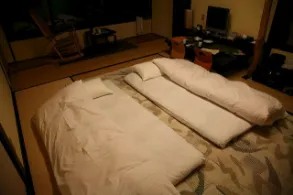
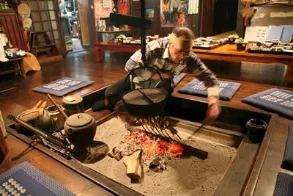
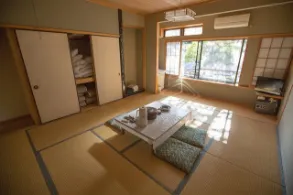
The classic Japanese inn, Ryokan come in many styles, but are united by flawless service and exquisitely-prepared food. Ryokan may be in modern or traditional wooden buildings, but rooms are always Japanese style, with Tatami (straw mat) floors and futons for sleeping laid out in the evening by the Ryokan staff. Minshuku are similar to Ryokan but family-run and with less formal service. Rooms are more simply-furnished and guests typically lay out their own futons.
As with Ryokan, the meal at a Minshuku is the highlight of the stay. Many Minshuku owners grow their own vegetables; fish, meat and other ingredients are sourced fresh each day.
Both Ryokan and Minshuku provide cotton Yukata gowns you wear after check-in. Wear them, too, when eating dinner or going for a short stroll outside. Ryokan rooms sometimes have private bathrooms, but Minshuku offer toilet and bathing facilities ‘along the corridor’. Baths may be smaller rooms, used privately in turn by guests; or they may be larger communal bathing suites, one for men and one for women.
At Japanese inns on the tour, tatami-mat rooms are culturally less intimate spaces than western bedrooms and Japanese guests travelling in a group are accustomed to sharing. On our small-group guided tours, we follow this Japanese custom and will ask solo travellers to share a tatami-mat room with another group member of the same gender.
Ryokan and Minshuku Etiquette
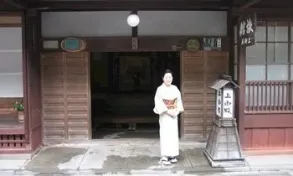
Arrival
When you arrive, step inside the Genkan street-level entrance area. Call out ‘gomenkudasai’ to attract attention if necessary. Remove your shoes and step up onto the raised interior floor, without touching the Genkan floor with your stocking feet. Leave your shoes in the Genkan area.
Slippers are normally available near the entrance for your use. Your hosts may ask you to write in the register or hand over your passport so they can take your details. The Ryokan owner or staff member will show you to your room and explain the time and place for meals, the location and hours of the bathing area.
As you enter your room, remove your slippers before stepping onto the Tatami matting. You should only tread on the Tatami mats in socks or bare feet. The slippers can be worn anywhere else inside the inn, except the toilets. Many inns provide special outdoor Geta clogs if you want to go outside without putting your shoes back on.
In your room you will usually find a small table with a tea set, a hot water flask and a welcome sweet. Look in the closets for your Yukata cotton robe and an Obi sash to tie it. You will usually find a small, white towel for washing and bathing. You may also find a small toothbrush and toothpaste kit.
Put on your yukata over your underwear. You can wear the yukata anywhere inside the Ryokan, including the dining area; it is also acceptable to wear the yukata outside. Wrap the left side of the Yukata over the right side. Most guests like to bathe before dinner – some like to bathe both before and after! If your room has a private bathroom, you will find shampoo and liquid soap, but do not take these to the communal baths as they will be supplied there too. Do take your small white towel to the communal bathing area.
Bathing
Ryokan have communal bathing areas, segregated by gender, with large baths and showers. Ryokan near thermal water sources have natural hot-spring baths called Onsen. There may be both indoor and outdoor baths - see our page on Hot Springs for more information. Even if your room has its own private bath, it is well worth trying the larger communal facilities.
Smaller Ryokan and Minshuku may offer bathing only in the evening and they will tell you the times when you arrive. Japanese guests traditionally bathe in the evening and communal baths or showers may not be available in the morning.
The bathing area will normally have Noren curtains over the entrance - red for women, blue for men. Inside you will find the changing area, with shelves and baskets for your clothing. Remove your clothes, place them in the basket and keep with you just your small white hand towel. If you have a larger bath towel too, leave it in the basket as it will get wet if taken into the bathing area. It is acceptable for men to take a razor for shaving into the washing area.
Proceed to the bathing area. Smaller inns may have a bath large enough for only a few people, or a small domestic tub used privately in turn by guests. Larger Onsen inns may have baths which can accommodate 25, 50 or more people. Take a small stool and bucket and find a free space in front of the taps and showers. Sit on the stool and use your white hand towel to wash yourself, using the supplied shampoo and liquid soap.
Once you have scrubbed yourself thoroughly, rinse all the soap from your body before entering the bath tub - you will be very unpopular with your fellow bathers if you make the water soapy! Leave your hand towel on the side of the bath or nearby, but do not immerse in the bath water. If you are bathing privately, do not drain the bath following your soak.
Many Japanese wash, soak, then wash again. It is fine to take your time soaking, relaxing and chatting to your neighbours.
Dinner
Dinner is served in your room or, more usually, in the dining area. Dinner time and breakfast time will be explained when you check in. Ryokan staff may announce when your meal is ready. You can eat dinner in your regular clothes or your yukata, whichever you prefer.
Most Japanese guests eat dinner in their yukata, but wear regular clothes for breakfast if they are planning to check out shortly afterwards.
Please be ready for dinner at the appointed time. Leave your room fairly tidy as Ryokan staff may come and lay out your futon while you are eating dinner. They will move the table to the side of the room and put the futons in the middle.
You can order drinks with your meal - beer comes in medium (‘chu’) or large (‘dai’) bottles; sake is served hot or cold; soft drinks and juices are available too. Wine may also be offered – either imported or Japanese wine from Yamanashi, west of Tokyo. There is no charge for iced water and tea; pay for other drinks when you check out from the inn.
After dinner, you may find your futon laid out and ready for sleeping in your room. If you are staying in a Minshuku, your futon is stored in the cupboard ready for you to lay out by yourself. Some inns have vending machines for beer, sake and soft drinks. Others sell drinks at the front desk or in the gift shop; it is perfectly acceptable to purchase drinks and consume them in your room.
Departure
Some inns may not accept card payment. Please make sure you have sufficient Japanese Yen cash if they don't. Settle the bill for drinks and any additional extras at the front desk.
Your shoes will normally be placed neatly in the Genkan ready for you in the morning. The staff may come out to wave good bye to you.
Yamagoya
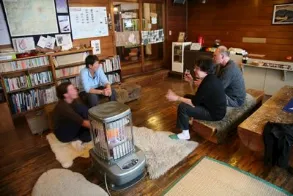 The Japanese version of the mountain lodge, Yamagoya are dotted along the trails of Japan's many national parks.
The Japanese version of the mountain lodge, Yamagoya are dotted along the trails of Japan's many national parks.
Yamagoya are usually more simply-furnished than Ryokan or Minshuku but their spectacular locations make them worthwhile destinations.
Yamagoya are a great place to meet Japanese hikers and see another side to this amazing country.
Shukubo
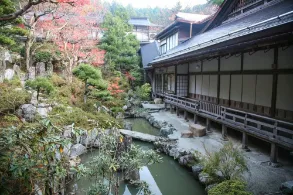 Shukubo are lodgings in Buddhist temples originally meant for pilgrims, but now open to anyone. The rooms are similar to Ryokan or Minshuku, but usually without private bathrooms. Food is usually wonderful vegetarian Buddhist ‘shojin-ryori’ cuisine.
Shukubo are lodgings in Buddhist temples originally meant for pilgrims, but now open to anyone. The rooms are similar to Ryokan or Minshuku, but usually without private bathrooms. Food is usually wonderful vegetarian Buddhist ‘shojin-ryori’ cuisine.
It is a wonderful experience to stay in a Shukubo and there may be an opportunity to join the early morning religious service.
Hotels
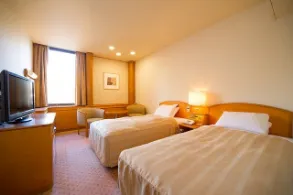 Japanese hotels have western-style rooms with beds; some may have Japanese-style Tatami rooms also. They have the same amenities as those in other countries, although room sizes are generally smaller. Hotels in Japan generally offer twin rooms; double rooms are less common and sometimes smaller than twin rooms.
Japanese hotels have western-style rooms with beds; some may have Japanese-style Tatami rooms also. They have the same amenities as those in other countries, although room sizes are generally smaller. Hotels in Japan generally offer twin rooms; double rooms are less common and sometimes smaller than twin rooms.